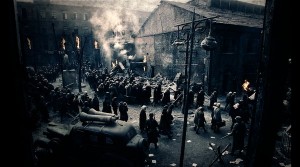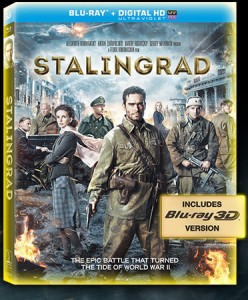 Disc Dish recently sat down with acclaimed Russian filmmaker Fedor Bondarchuk (9th Company) who, as the son of the Academy Award-winning director Sergei Bondarchuk (War and Peace), was introduced to the world of cinema at an early age
Disc Dish recently sat down with acclaimed Russian filmmaker Fedor Bondarchuk (9th Company) who, as the son of the Academy Award-winning director Sergei Bondarchuk (War and Peace), was introduced to the world of cinema at an early age
Bondarchuk’s latest film is Stalingrad (Sony, DVD $30.99, Blu-ray 3D/Blu-ray $35.99; Street: May 13), an epic look at the battle that turned the tide of World War II. Focusing on a band of determined Russian soldiers fighting to hold a strategic building in their devastated city against a ruthless German army (and in the process becoming deeply connected with two Russian women who live there), Stalingrad ranks as the highest-grossing Russian film of all time and Russia’s official submission for Best Foreign Language Film to the 86th Academy Awards.
Disc Dish: The story of Stalingrad has been the subject of many films and documentaries in Russia and the U.S. over the past half-century. How and why did you become involved in Stalingrad, a new look at one of WWII’s most infamous and well-known battles.
Fedor Bondarchuk: The second World War is a sacred theme in Russia and over the years, it has usually been depicted in a very conservative way. From the beginning, had there not been the technology for the production, I would not have approached it at all. I want to make a film that has never been thought of or made before in Russia. And it’s not about the type of editing in the film—it’s about the color correction, it’s about the large IMAX image, it’s about a war drama in 3D. And this is extremely unusual in Russia. We have only sci-fi or cartoons or Marvel and DC comics in theaters in IMAX 3D. Just imagine a war drama in 3D by the rules of classical war drama films! It’s very unusual, for us as the filmmakers and for the Russian audience. In Russia, we have only documentary and research in one hand, or classical black-and-white films on the other hand. This is new territory. The idea was to allow people to get closer to the events that actually happened—to immerse them through the large-scale format and through 3D. I told everybody—my director of photography, my sound producer, my art department—we must use the most modern technology that is available. For sound design, in particular, we had to use the most modern sound design, with full stereo.
DD: You’ve described Stalingrad an attempt to put a ‘skaz’ on screen, a uniquely Russian style of literature that’s considered to be something between a tale and a myth. Can you describe what ‘skaz’ is for Western audiences?
 FB: Skaz is indeed a myth, a legend. If the film was done in Europe, you could call it the ‘Saga of Stalingrad.’ Russian audiences are familiar with the genre, the idea, of skaz. It is taking a something that everyone knows, in this case, the story of Stalingrad, and presenting it in a new way. Every 25 years, not only does the audience change, but also the technology of cinema changes. With this new technology—IMAX and 3D and stereo sound—I want to offer to the audience a new way to hear a story that everybody knows. The legend becomes bigger and it is fresher to the audience of today with the new technology.
FB: Skaz is indeed a myth, a legend. If the film was done in Europe, you could call it the ‘Saga of Stalingrad.’ Russian audiences are familiar with the genre, the idea, of skaz. It is taking a something that everyone knows, in this case, the story of Stalingrad, and presenting it in a new way. Every 25 years, not only does the audience change, but also the technology of cinema changes. With this new technology—IMAX and 3D and stereo sound—I want to offer to the audience a new way to hear a story that everybody knows. The legend becomes bigger and it is fresher to the audience of today with the new technology.
DD: The new technology truly seems to be one of the primary inspirations for your take on this film!
FB: To be honest, I never thought that my next project would be a large-scale war drama. ‘Why make another statement about war?,’ I asked myself. Then I found my answer: IMAX 3D technologies, which gave us an opportunity to show a detailed, true-to-life world. I wanted to place the modern audience into a besieged, scorched city in November, 1942, and to obliterate the border between the screen and the audience. On one hand, we are talking about new technologies and our attempts to make the visual and sound effects as impressive as possible. On the other hand, besides this deliberately chosen course, we went back to the classics of film narration, back to the origins—to intra-frame editing, longs scenes, and long shots.
DD: Shot over 80 days, Stalingrad is epic in scope, ranging from large-scale battle sequences filled with extras, weapons, tanks and digital effects, to smaller, more intimate scenes between a handful of actors. But the new technology was undoubtedly the trickiest part. What were the most challenging aspects of shooting the film in IMAX 3D?
 FB: Making a film with the IMAX 3D process was like putting salt on your food. A little bit too much, and the dish doesn’t taste good. But with too little, it doesn’t add any flavor. It’s a very fine line when you are deciding how much IMAX 3D to put into the film.
FB: Making a film with the IMAX 3D process was like putting salt on your food. A little bit too much, and the dish doesn’t taste good. But with too little, it doesn’t add any flavor. It’s a very fine line when you are deciding how much IMAX 3D to put into the film.
DD: Stalingrad most definitely has the feel of an old-fashioned war movie with a modern technological sheen. While the work of your father [the late Russian filmmaker Sergei Bondarchuck of 1966’s War and Peace fame] was clearly an inspiration, was their any classical Hollywood war cinema that influenced your direction of the film?
FB: Apocalypse Now, Black Hawk Down and Saving Private Ryan were all influential to me.
DD: All of those are modern Hollywood war movies that approached their subjects with a classical style.
FB: Yes, yes very much.
DD: The orchestral score for Stalingrad was composed by Angelo Badalamenti, who is best known for his compositions for David Lynch’s works, most notable Blue Velvet and TV’s Twin Peaks. What was your experience working with him?
FB: I got the feeling that he was waiting for this film! He brought so much energy and so many ideas to Stalingrad’s music. He was a part of the production before we even started shooting. I sent him my first film, [the war film] The 9th Company, and told him that I wanted to make a war film of that size about Stalingrad. He did many films with David Lynch, and Lynch and my father both had the same producer, Dino de Laurentis, who worked with my father on his film Waterloo with Christopher Plummer and also worked with David Lynch on Dune. Badalamenti worked with a symphony orchestra for two weeks when they recorded the soundtrack in Moscow.
DD: Stalingrad comes to the U.S. with a list of major accomplishments – the highest grossing film in post-Soviet Union Russia, the first Russian film shot in IMAX and IMAX 3-D, the best-ever start for a film in China outside of a Hollywood film, amongst others. Why was it important that Stalingrad be that film?
FB: It was very important for me and I’m very proud of the positive reception Stalingrad received in Russia and outside of Russia. As a Russian citizen, I personally wanted to see a movie about the occupation of Stalingrad, and my approach coincided with the audience, who wanted to see it as well. For me, it is completely unimportant how it is perceived politically. It is everyone’s right to see it as politically as they wish, but that was not important for the film’s creators. We didn’t want to create propaganda. It was not created as propaganda—it is patriotic. The success of Stalingrad proves that Russian cinema is valued and that we can produce convincing films on a large scale. It means that the industry has grown and that we’re capable of doing high quality projects.
|
Buy or Rent Stalingrad
|
|||
|---|---|---|---|
DVD |
 DVD | Blu-ray 3D DVD | Blu-ray 3D |
 DVD | Blu-ray 3D DVD | Blu-ray 3D |
|
Leave a Reply